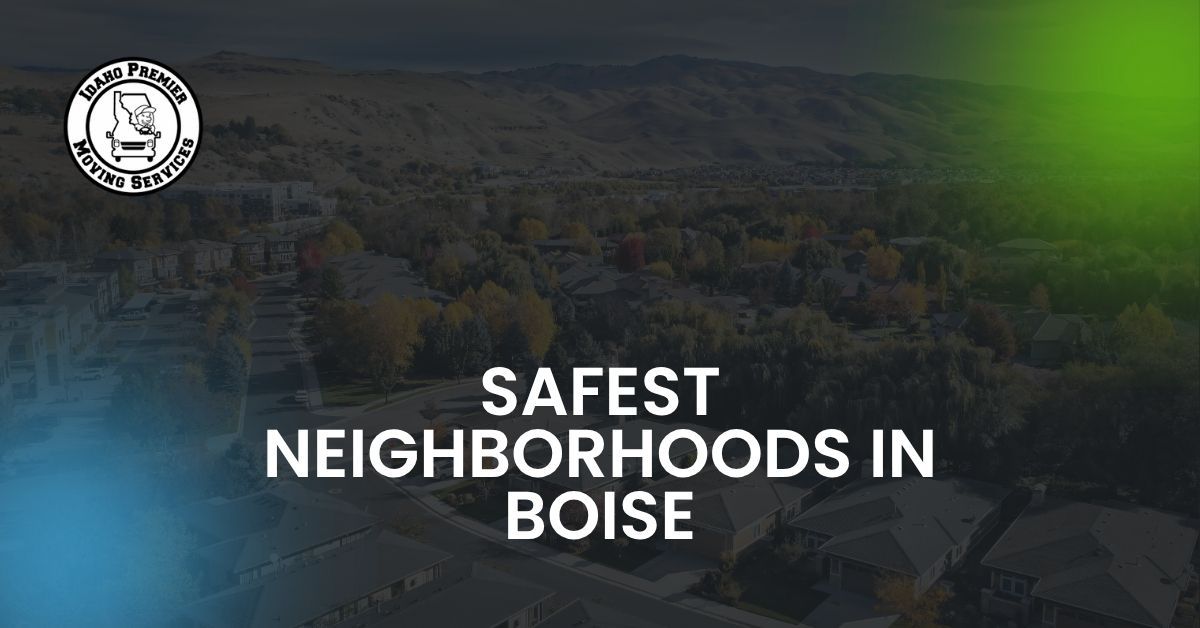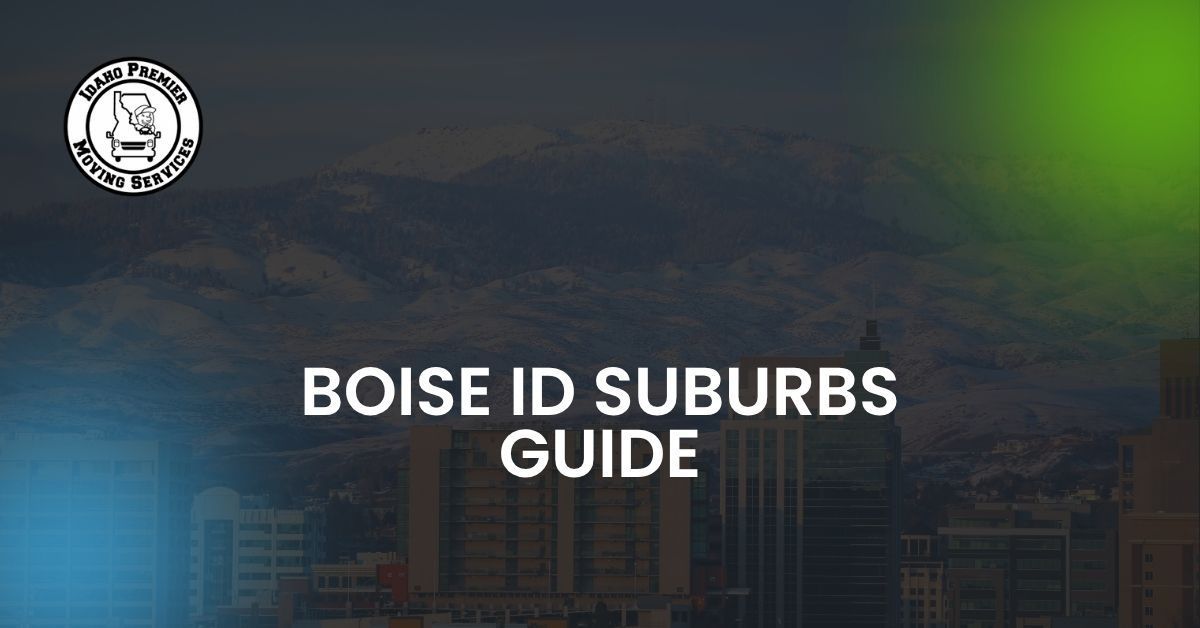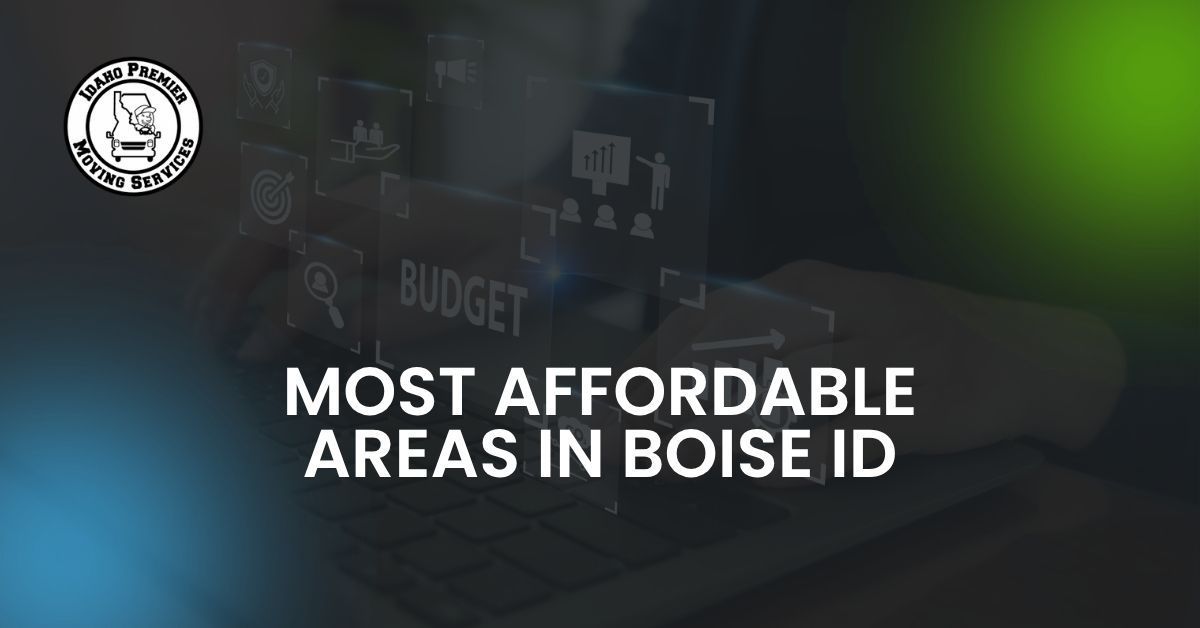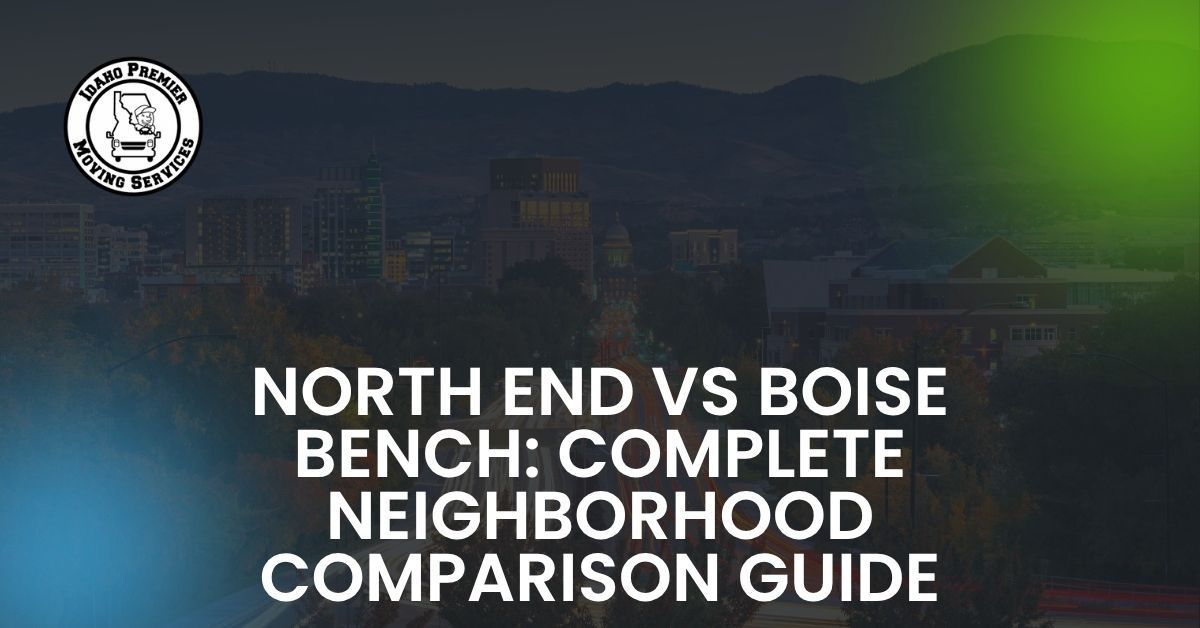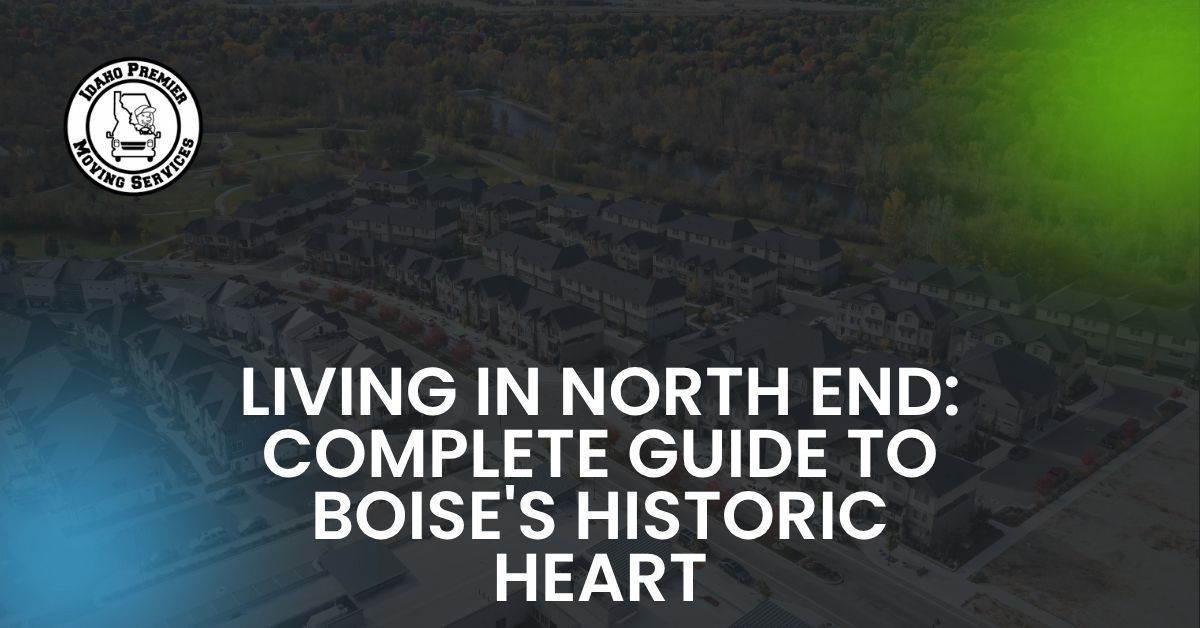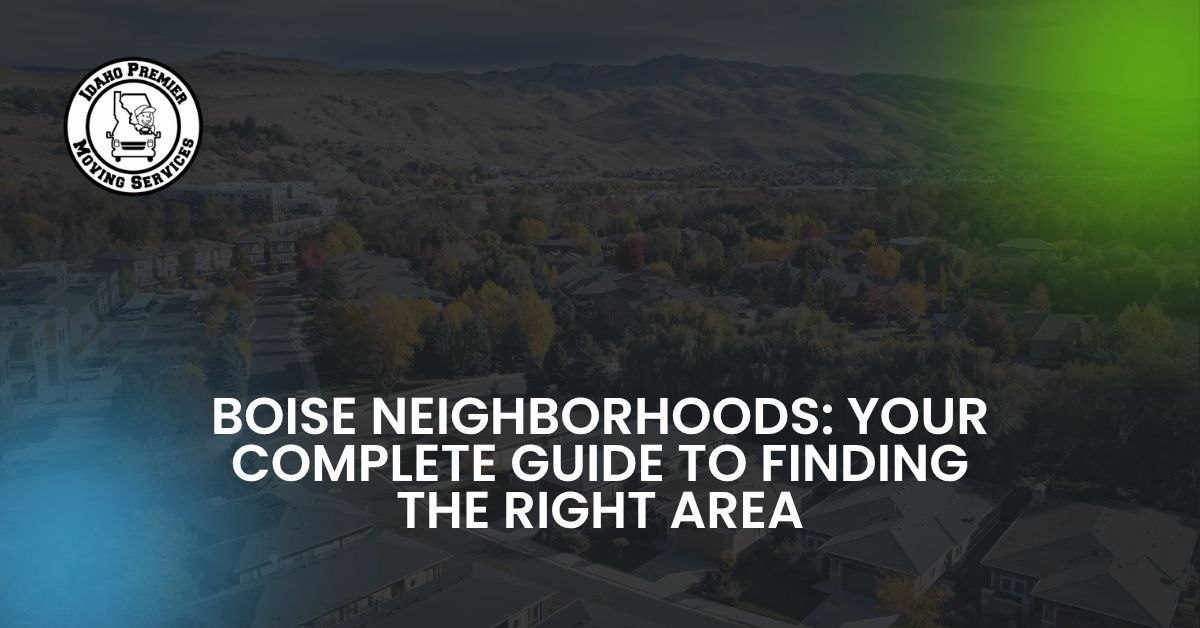Boise City Guide Everything You Need to Know About Moving to Boise, Idaho

We know that planning a move is both exciting and overwhelming. You're considering Boise, Idaho—maybe because of a job opportunity at one of the tech companies flourishing here, the outdoor recreation that puts mountains and rivers at your doorstep, or simply the appeal of a mid-sized city offering big-city amenities with small-town friendliness. You're scrolling through listings, researching neighborhoods, and wondering what daily life actually looks like in the "City of Trees."
That's exactly why we created this comprehensive Boise city guide. As your trusted local partner at Idaho Premier Moving, we've helped hundreds of families and individuals make the transition to Boise. We've moved young professionals into downtown lofts near 8th Street, helped families settle into homes in the Boise Bench area, and assisted retirees relocating to Idaho's capital for its quality of life—always with the professionalism and care that defines premier moving service.
Boise isn't just another Western city. This metropolitan area of approximately 750,000 residents (city proper around 240,000) has transformed from Idaho's sleepy capital into one of America's fastest-growing and most desirable cities. You'll find a thriving downtown along Capitol Boulevard, world-class outdoor recreation along the Boise River Greenbelt, a booming economy attracting companies like Micron Technology and HP, and a quality of life consistently ranking Boise among the nation's best places to live.
In this guide, we'll walk you through everything you need to know about living in Boise—from neighborhoods and housing to schools, cost of living, employment, and lifestyle. Whether you're relocating from across the country or moving from elsewhere in Idaho, you'll find the information you need to make Boise feel like home.
Boise: Location and Character
Before diving into specifics about living in Boise, it helps to understand what defines this city and where it sits within the broader region.
Boise serves as Idaho's capital and largest city, located in the Treasure Valley along the Boise River at the base of the Boise Foothills. The city sits at approximately 2,700 feet elevation, nestled between desert and mountains, creating that distinctive high-desert landscape with snow-capped peaks as backdrop.
Interstate 84 runs through Boise connecting to points west toward Oregon and east through Idaho. State Street and Fairview Avenue serve as major east-west arterials, while Broadway Avenue and Capitol Boulevard run north-south through the heart of the city.
What is Boise like in terms of character? It's fundamentally an outdoor recreation city—where mountain biking, skiing, river activities, and hiking aren't weekend hobbies but lifestyle foundations. The Boise River Greenbelt—a 25-mile pathway following the river through the city—serves as both transportation corridor and community gathering space, embodying Boise's commitment to outdoor access and quality of life.
Downtown Boise along 8th Street and the BoDo district showcase the city's evolution from government town to dynamic urban center. Historic buildings house Barbacoa Grill, Bittercreek Alehouse, Bardenay (Idaho's first distillery), and businesses ranging from outdoor retailers like Idaho Mountain Touring to tech startups in converted warehouses.
The Idaho State Capitol dominates downtown's skyline—a beautiful neoclassical building that's one of few state capitols heated by geothermal water. Boise State University with its distinctive blue football field brings 25,000+ students and creates vibrant university culture. St. Luke's Health System and Saint Alphonsus Health System anchor healthcare, while Micron Technology's massive semiconductor facility drives the regional economy.
Population growth tells Boise's story clearly. The metro area has grown approximately 20% in the past decade, fueled by people fleeing expensive coastal cities, remote workers discovering Idaho's advantages, companies relocating operations, and retirees seeking active outdoor lifestyle at lower cost than mountain resort towns. The Boise Metro Chamber actively works to manage growth while maintaining quality of life.
For a comprehensive look at the different areas where you might live, our detailed Boise Neighborhoods: Complete Area Guide breaks down each community's character, amenities, and ideal residents—helping you understand whether you're better suited for downtown urban living, foothill neighborhoods, or suburban communities.
Boise Neighborhoods: Finding Your Community
One of the most important decisions when moving to Boise is choosing which neighborhood will become your home. The city offers remarkable diversity—from urban downtown living to foothill neighborhoods with mountain access to family-oriented suburbs to rural-feeling areas within city limits.
Downtown Boise and the BoDo (Boise Downtown) district offer the city's most urban experience. High-rise condos, converted loft apartments, and townhomes put residents within walking distance of Boise Centre, The Egyptian Theatre, restaurants like Fork, Chandlers Steakhouse, and nightlife along 8th Street. This area attracts young professionals, empty-nesters, and those who value walkability and urban culture.
North End represents Boise's most established and desirable neighborhood, featuring tree-lined streets, historic homes from the early 1900s, proximity to Hyde Park commercial district with its shops and cafes like Hyde Perk, and immediate access to Camel's Back Park and foothill trails. Properties range from charming bungalows to substantial renovated homes, attracting professionals, artists, and longtime Boiseans.
East Boise encompasses neighborhoods east of downtown toward Boise State University, featuring a mix of older homes, student rentals, and young families. Julia Davis Park, Zoo Boise, and Boise Art Museum anchor the area, with the Greenbelt providing recreation and transportation.
Southeast Boise includes newer developments and suburban neighborhoods offering family-oriented living with good schools, parks, and accessibility. Areas near Barber Park and along Warm Springs Avenue provide suburban comfort with easy access to outdoor recreation.
West Boise and Meridian (technically separate city but functionally connected) represent the primary growth areas with newer subdivisions, master-planned communities, and that contemporary suburban lifestyle. The Village at Meridian shopping district and abundant retail make this area particularly convenient for families.
Boise Bench sits on the plateau south of downtown, featuring mid-century homes, diverse demographics, and affordability compared to North End or foothills. The area attracts first-time buyers, working families, and those prioritizing value and convenient access to both downtown and outdoor recreation.
Foothills neighborhoods along Bogus Basin Road and throughout the hills provide mountain living within city limits—homes with views, wildlife, proximity to Bogus Basin ski area, and that mountain town feel. Properties here command premiums for location and views.
Each area of Boise attracts different demographics and offers different lifestyles. Downtown emphasizes urban walkability. North End combines character and outdoor access. Suburbs prioritize schools and convenience. Foothills deliver mountain living.
For detailed analysis of each neighborhood—including specific subdivisions, school assignments, home styles, price ranges, and who thrives in each area—explore our comprehensive Boise Neighborhoods: Complete Area Guide. This resource will help you narrow your search based on your specific priorities, whether that's walkability, outdoor access, schools, or budget.
Housing in Boise: Rentals and Real Estate
Understanding Boise's housing market is crucial for planning your move and budget. The real estate landscape here has experienced dramatic transformation over the past decade as the city grew from undiscovered gem to nationally-recognized destination.
The Boise real estate market has seen explosive appreciation since 2015, with particularly dramatic growth during 2020-2022 as remote workers and refugees from expensive markets flooded in. While growth has moderated, prices remain well above pre-pandemic levels. Single-family homes range from approximately $350,000 for smaller or older properties to $1 million+ for premium locations in foothills or North End.
The sweet spot for most buyers falls in the $450,000-650,000 range, which typically delivers 1,800-2,500 square foot homes in good neighborhoods with decent access to schools and amenities. This represents substantial increase from a decade ago when similar homes sold for $250,000-350,000, reflecting Boise's transformation from affordable to increasingly expensive.
New construction continues actively in growth areas like Meridian, Eagle, and southeast Boise, with builders including Hubble Homes, CBH Homes, Brighton Corporation, and others developing subdivisions. These provide move-in ready homes with warranties and modern features, though at premium prices reflecting current market conditions.
For those exploring the rental market in Boise, options range from downtown apartments at $1,200-2,000/month for one or two bedrooms, to single-family home rentals in the $1,800-3,000/month range depending on size and location. Apartment complexes like those near Boise Towne Square and along Fairview Avenue provide convenient access to shopping and employment.
Rental inventory remains tight given population growth, and competitive markets mean prospective tenants often face multiple applicants for desirable properties. Having rental applications ready and responding quickly to listings provides advantage.
Property taxes in Ada County (where Boise sits) run approximately 0.6-0.8% of assessed value annually—significantly lower than many states and one of Idaho's competitive advantages. Combined with no state sales tax on groceries and generally lower cost structure than coastal states, this creates more manageable total tax burden.
Working with real estate agents familiar with Boise's specific neighborhoods, market dynamics, and recent comparable sales is essential. The Intermountain Multiple Listing Service covers the region, and local agents understand nuances between neighborhoods and current market conditions that aren't apparent from online listings.
For comprehensive guidance on navigating Boise's housing market—including neighborhood-specific pricing, tips for buyers in competitive markets, rental strategies, and understanding local market dynamics—our detailed Finding Housing in Boise: Complete Rental & Real Estate Guide provides everything you need to make informed housing decisions.
Cost of Living: What to Expect in Boise
Understanding the full picture of Boise's cost of living is essential for budgeting your move and ensuring this city fits your financial situation. While housing costs have risen dramatically, the complete financial picture encompasses utilities, transportation, groceries, healthcare, and taxes.
Housing costs in Boise have transformed from the city's greatest competitive advantage to a growing concern. What was once remarkably affordable compared to western cities is now moderately expensive by national standards, though still well below coastal markets. The rapid appreciation has priced some longtime residents out while remaining attractive to those relocating from California, Seattle, or other high-cost areas.
Utilities in Boise remain reasonable, with electricity from Idaho Power generally affordable due to hydroelectric generation. Winter heating costs vary significantly based on home age, insulation, and system efficiency—expect $80-200 monthly during cold months depending on home size. Water and sewer through the City of Boise or United Water add $60-100 monthly.
Transportation costs depend heavily on your lifestyle and location. Boise's sprawling layout means most residents drive regularly, though downtown residents can minimize vehicle dependence. Gasoline costs reflect regional averages, moderate by national standards. Vehicle registration and insurance costs in Idaho run below many states, providing savings.
Groceries and daily expenses in Boise run at or slightly below national averages. Major chains including Albertsons, Fred Meyer, WinCo Foods, Costco, and Trader Joe's provide competitive pricing. The presence of Boise Co-op and Western Collective offers local and organic options at premium pricing for those prioritizing these factors.
Healthcare costs benefit from competition between St. Luke's Health System and Saint Alphonsus Health System, two comprehensive providers offering quality care. Healthcare costs in Idaho run roughly at national averages, with excellent facilities available locally.
Taxes present Idaho's mixed picture. Property taxes are low (0.6-0.8% annually), a significant advantage. However, Idaho's state income tax reaches 5.8% for high earners—not the highest nationally but higher than some neighboring states. Sales tax in Boise runs 6%, moderate by national standards, and groceries are exempt from sales tax.
Recreation costs vary dramatically by lifestyle. Outdoor recreation—hiking, biking, river activities—is essentially free beyond initial equipment investment. Bogus Basin ski area offers season passes at $600-900, remarkably affordable compared to major resorts. Entertainment, dining, and cultural activities cost less than major metros while offering quality options.
Overall, Boise's cost of living index runs approximately 5-15% above national average, driven primarily by housing cost increases. For those relocating from expensive coastal markets, Boise feels affordable. For those from lower-cost regions or longtime Boiseans, the increases feel substantial.
For a detailed breakdown of every cost category—including neighborhood-specific costs, utility comparisons, transportation calculations, and budget planning tools—our comprehensive Boise Cost of Living: Complete Budget Guide provides the numbers you need to plan your Boise budget accurately.
Schools and Education in Boise
For families moving to Boise, school quality often ranks among top priorities. Understanding the education landscape here requires looking at multiple school districts, charter schools, and higher education opportunities.
Boise School District serves the city proper with approximately 26,000 students across numerous elementary, middle, and high schools. The district operates neighborhood schools throughout Boise, with quality varying somewhat by campus. Schools in North End and foothills areas generally benefit from engaged parent communities and strong resources, while schools in lower-income areas face more challenges though dedicated staff work hard.
High schools include:
- Boise High School (serving downtown and west Boise)
- Borah High School (southeast Boise)
- Capital High School (northwest areas)
- Timberline High School (south Boise)
Performance varies by campus, with all offering comprehensive programs but some showing stronger test scores and college preparation than others. Families should research specific schools using Idaho Department of Education data and parent reviews.
Meridian School District serves the rapidly growing area west of Boise, operating numerous schools to accommodate the region's expansion. The district has invested heavily in facilities and programs, with many newer schools and generally strong performance. Meridian's growth has brought both opportunities and challenges of maintaining quality while expanding rapidly.
West Ada School District covers Eagle and western areas, also experiencing substantial growth. The district maintains solid performance and continues building new facilities.
Charter schools thrive in Idaho's favorable regulatory environment, with numerous options including Anser Charter School (downtown Boise, arts-focused), Compass Public Charter School, Liberty Charter School, and others. These provide alternatives to traditional district schools, though demand often exceeds capacity requiring lotteries.
Private schools include Bishop Kelly High School (Catholic), Foothills School of Arts and Sciences, The Academy, and various religious schools. Tuition typically ranges from $8,000-15,000+ annually depending on school and grade level.
Boise State University dominates higher education with 25,000+ students pursuing degrees across comprehensive programs. The university brings cultural vitality, sports excitement (particularly football with that famous blue turf), and research capacity. College of Idaho in nearby Caldwell offers small liberal arts alternative.
School quality in Boise requires research—the districts serve diverse populations with varying resources, and individual school performance matters more than district-wide reputation. However, families can find excellent public school options throughout the area with proper research.
Employment and Economy: Working in Boise
Understanding Boise's employment landscape and economy is crucial whether you're relocating for a specific job or searching for opportunities after your move. The city's economic profile has diversified significantly, transforming from government-dominated to technology-driven while maintaining diverse employment base.
Micron Technology serves as Boise's largest private employer with thousands working at the massive semiconductor manufacturing facility. The company's presence drives the regional economy, attracts related businesses, and provides high-paying technical jobs. Micron's fortunes directly affect Boise's economic health.
St. Luke's Health System and Saint Alphonsus Health System employ thousands across hospitals, clinics, and administrative functions. Healthcare provides stable employment across skill levels from physicians and nurses to technical and support positions.
Boise State University employs faculty, administrators, and support staff while also generating economic activity through student spending and research operations.
State of Idaho government employs thousands in the capital, from legislators and executive branch to agencies administering programs statewide. Government provides stable employment with benefits, though typically at lower pay than private sector equivalents.
Hewlett Packard (HP) maintains significant operations in Boise, continuing a tech presence dating decades. Cradlepoint (acquired by Ericsson), Clearwater Analytics, Kount (fraud prevention), and numerous other tech companies create growing technology sector attracting talent and investment.
Albertsons grocery chain maintains headquarters in Boise (though corporate ownership is complex), providing corporate employment. J.R. Simplot Company (agricultural products) represents another major employer with deep Idaho roots.
Outdoor industry companies including KAST Gear, various startups, and industry organizations locate in Boise specifically for lifestyle and proximity to outdoor recreation that defines the region.
Small business and entrepreneurship thrive in Boise's culture, from outdoor companies to tech startups to restaurants and services. The Boise Metro Chamber, Boise Young Professionals, and various organizations support business development and networking.
The unemployment rate in Boise and Ada County typically runs at or below state and national averages, benefiting from diversified economy and continuing growth. Job seekers with technology skills, healthcare credentials, or professional backgrounds generally find opportunities.
Remote work has become significant, with many Boise residents working remotely for companies based elsewhere—particularly California tech firms. The lifestyle, lower costs, and quality of life make Boise attractive for remote workers, though this has contributed to housing cost increases as people bring high salaries to moderate cost market.
The job market favors those with skills and experience, while entry-level positions and hourly jobs face wage pressure from rising living costs. The economy continues diversifying beyond Micron dependence, creating more stability and opportunity.
Things to Do: Lifestyle and Recreation in Boise
One of Boise's strongest appeals is its lifestyle and recreation options—particularly outdoor activities that define daily life for many residents. Understanding what makes Boise special helps envision whether this city matches your priorities.
Boise River Greenbelt serves as the city's recreational spine—25 miles of paved pathway following the river through multiple cities from Lucky Peak Reservoir to Eagle. Residents walk, run, bike, and commute on the Greenbelt daily, and summer brings tubing, fishing, and waterfront recreation. This linear park embodies Boise's outdoor culture and quality of life commitment.
Foothills trails provide immediate mountain access from city neighborhoods. Table Rock, Hull's Gulch, Military Reserve, and dozens of other trails accommodate hiking, mountain biking, and trail running with stunning valley views. Winter brings backcountry skiing and snowshoeing. The Foothills represent Boise's backyard and shape lifestyle profoundly.
Bogus Basin ski area sits 16 miles from downtown, providing downhill and nordic skiing, snowboarding, and winter recreation with remarkable accessibility. Season passes cost $600-900—affordable by ski resort standards—making winter sports practical for middle-class families rather than luxury activities.
Downtown Boise along 8th Street and surrounding blocks offers dining, culture, and entertainment. Basque Block celebrates Boise's unique Basque heritage with restaurants like Bar Gernika and Leku Ona. BoDo district features Fork, Bittercreek Alehouse, Barbacoa Grill, and evolving restaurant scene. The Egyptian Theatre and Morrison Center provide cultural programming.
Shopping centers on Boise Towne Square mall and retail along Milwaukee Street, Eagle Road, and major corridors. Downtown boutiques include outdoor retailers, local shops, and businesses catering to urban residents.
Outdoor recreation extends beyond city limits to Lucky Peak Reservoir for boating and swimming, Sawtooth National Forest for camping and wilderness, Sun Valley for world-class skiing (2.5 hours north), and endless desert and mountain terrain for adventure.
Cultural attractions include:
- Boise Art Museum featuring regional and contemporary art
- Idaho State Museum showcasing state history
- Zoo Boise popular with families
- Boise Philharmonic and live music venues
- Various galleries and community cultural organizations
Sports include Boise State Broncos football creating fall excitement, minor league baseball with Boise Hawks, hockey with Idaho Steelheads, and various other teams and events at ExtraMile Arena and Albertsons Stadium.
Events and festivals throughout the year include Treefort Music Fest (indie music), Boise Farmer's Market (year-round), Hyde Park Street Fair, and various seasonal celebrations.
The lifestyle in Boise centers fundamentally on outdoor access and recreation. Weekends involve hiking, biking, skiing, or river activities depending on season. Evenings bring Greenbelt walks or runs. This outdoor orientation isn't an affectation—it's genuine culture that shapes who thrives here.
Weather and Climate: Four Distinct Seasons
Understanding Boise's weather and climate is essential for both daily life planning and long-term adaptation to high-desert mountain living. The climate here is classified as semi-arid, characterized by hot summers, cold winters, and moderate precipitation.
Summer from June through August brings hot, dry conditions with temperatures typically reaching high 80s to mid-90s°F (30-35°C), occasionally exceeding 100°F (38°C) during heat waves. However, low humidity makes heat more tolerable than humid climates, and evenings cool significantly. Summer brings virtually no rain—months can pass without precipitation, creating fire season concerns in surrounding forests.
Winter from December through February brings cold temperatures with highs typically in the 30s-40s°F (0-7°C) and lows in the 20s°F (-5 to 0°C). Snow is common but typically melts between storms rather than accumulating for months. The valley experiences temperature inversions trapping cold air and creating foggy, gloomy conditions that can persist for weeks—this valley fog frustrates many residents though foothills remain sunny above the inversion layer.
Spring (March-May) and Fall (September-November) provide Boise's most pleasant weather with moderate temperatures and occasional precipitation. Spring can be variable with warm days followed by cold snaps, while fall typically brings stable, beautiful weather perfect for outdoor activities.
Precipitation averages only 12 inches annually, making Boise genuinely arid. Most precipitation falls during winter and spring, with summer typically bone-dry. This low precipitation means abundant sunshine—Boise averages 206 sunny days annually, well above national average.
Temperature extremes occur but aren't typical. Record high exceeds 110°F, while record low drops below -25°F, but these extremes are rare. Normal conditions are more moderate, though summers are reliably hot and winters reliably cold.
Air quality varies seasonally. Winter inversions can trap pollution and wood smoke creating unhealthy air quality for sensitive groups. Summer brings wildfire smoke from regional fires that can blanket the valley for days or weeks, affecting outdoor activities and health. Air quality awareness and monitoring through Idaho Department of Environmental Quality becomes part of life.
The weather shapes lifestyle profoundly in Boise—summer outdoor activities dominate from dawn till dusk taking advantage of long days and warm evenings. Winter brings skiing and snow sports for enthusiasts while others hunker down. Spring and fall provide optimal conditions for hiking, biking, and enjoying Boise's outdoor assets. Understanding and embracing seasonal patterns is part of thriving here.
Getting Around: Transportation in Boise
Understanding transportation and mobility in Boise is crucial for daily life, particularly given the city's moderate size and Western sprawling development patterns.
Driving dominates transportation in Boise, as in most Western cities. The sprawling layout, limited public transit, and car-centric development make personal vehicles essential for most residents. Major routes including Interstate 84, State Street, Fairview Avenue, Chinden Boulevard, and Broadway Avenue carry most traffic.
Traffic remains manageable by big-city standards—rush hour congestion occurs on major routes, but commutes rarely exceed 30 minutes within the metro area. The growth has brought increasing congestion, particularly along Eagle Road and routes connecting Boise to Meridian and Eagle, but nothing approaching gridlock common in larger metros.
Public transportation through Valley Regional Transit (VRT) operates bus routes throughout Boise and surrounding cities. Service is adequate for basic needs but limited compared to larger cities—routes run primarily on major corridors, frequencies are modest (often 30-60 minutes), and evening/weekend service is reduced. Transit works for specific commutes and purposes but doesn't provide comprehensive car-free living option for most residents.
Biking is increasingly viable in Boise, particularly for recreation and commuting via the Greenbelt. The city has invested in bike lanes and infrastructure, and the relatively flat valley and moderate climate (excluding winter snow and summer heat extremes) support cycling. However, suburban sprawl and gaps in bike network limit practical cycling to enthusiasts and those in well-connected neighborhoods.
Walking works in specific areas—downtown Boise, North End, and some compact neighborhoods support pedestrian life. However, most of Boise requires vehicles for daily activities given distances and limited neighborhood commercial services.
Airports:
- Boise Airport (BOI) sits just south of downtown with remarkably convenient access—typically 10-15 minutes from most Boise neighborhoods. The airport offers nonstop service to major western hubs including Seattle, Salt Lake City, Denver, San Francisco, Los Angeles, and others through Alaska Airlines, United, Delta, Southwest, and American. International travel requires connecting through major hubs.
The transportation reality in Boise: budget for vehicle ownership, maintenance, and fuel. Public transit provides limited alternatives, and while biking works for some purposes, comprehensive car-free living isn't practical for most residents. However, traffic remains manageable and convenient airport access partially compensates for auto dependence.
Planning Your Move to Boise
Now that you understand what life in Boise looks like, it's time to think about the practical aspects of actually making your move happen. Whether you're relocating from across the country or moving from elsewhere in Idaho, careful planning ensures a smooth transition.
Timeline considerations should start at least 2-3 months before your desired move date, particularly if you're buying rather than renting. Boise's competitive housing market moves quickly for desirable properties, and coordinating closings, inspections, and moving logistics requires adequate time.
Choosing your neighborhood should be your first priority. Will you live downtown for walkability and urban culture? In North End for character and foothill access? In Meridian for newer construction and family amenities? Your neighborhood choice affects everything from daily convenience to school assignments to long-term property values. Our detailed Boise Neighborhoods: Complete Area Guide helps you compare options and identify the best fit for your priorities.
Budget planning goes beyond just mortgage or rent. Factor in utility costs through Idaho winter, potential vehicle needs for Boise's sprawling layout, property taxes (though these are relatively low), and moving costs. Our comprehensive Boise Cost of Living: Complete Budget Guide provides detailed numbers for every cost category, helping you budget accurately.
Housing search should involve working with realtors familiar with Boise's specific market dynamics and recent shifts. Whether buying or renting, local expertise matters—understanding which neighborhoods are appreciating, which areas have specific advantages, and where best values lie requires insider knowledge. Our Finding Housing in Boise: Complete Rental & Real Estate Guide walks through the entire housing search process with local insights.
School research for families is essential if you have school-age children. Verify school assignments for any property through Boise School District or relevant district, and research specific campus performance. School quality varies across the region, making this research crucial.
Utility setup requires coordination with Idaho Power for electricity, Intermountain Gas for natural gas, City of Boise or United Water for water/sewer, and various providers for internet including CenturyLink, Sparklight, Ziply Fiber in some areas. Schedule these services to activate just before your arrival.
Vehicle considerations include transferring registration to Idaho (within 90 days), obtaining an Idaho driver's license from Idaho Transportation Department, and updating auto insurance. Idaho requires vehicle inspections in Canyon County but not Ada County (where Boise sits).
The moving process itself is where Idaho Premier Moving becomes your essential partner. We understand Boise's neighborhoods intimately—from navigating downtown's tight historic streets to coordinating access in foothill properties to timing moves in suburban developments. Our team has successfully relocated hundreds of families throughout Boise and the Treasure Valley.
We know which areas have difficult access requiring special equipment, when traffic is lightest for moving days, and how to efficiently navigate everything from high-rise condos downtown to homes on steep foothill lots. As experienced local professionals, we handle moves of all sizes with the expertise and care that defines premier service.
We offer comprehensive moving services including:
- Professional packing assistance
- Careful loading and secure transport
- Efficient unloading at your new Boise home
- Coordination for challenging access situations
- Full licensing and insurance
- Local knowledge that makes your move smoother
Post-move essentials include updating your address with USPS, transferring medical records to St. Luke's or Saint Alphonsus or chosen providers, registering to vote through Ada County Elections, exploring outdoor recreation options, and connecting with Boise's community. Join neighborhood groups, visit the Greenbelt, and start building your local network.
The key to a successful move to Boise is breaking the process into manageable steps: research neighborhoods, secure housing, plan budget carefully, coordinate logistics, and partner with experienced professionals who know this city inside and out.
Conclusion: Your Boise Journey Starts Here
Moving to Boise represents an exciting opportunity—whether you're drawn by outdoor recreation lifestyle, growing economy and job opportunities, lower costs than coastal cities, or simply the quality of life that makes Boise consistently rank among America's best places to live. This Boise city guide has provided the comprehensive overview you need to understand what living here entails, from neighborhoods and housing to schools, costs, employment, and lifestyle.
The information we've covered is just the beginning. Throughout this guide, we've linked to detailed resources that dive deeper into specific aspects of Boise living:
- Our Boise Neighborhoods: Complete Area Guide helps you compare every area and find your perfect community
- The Finding Housing in Boise: Complete Rental & Real Estate Guide walks you through the entire housing search process
- Our Boise Cost of Living: Complete Budget Guide provides detailed numbers for accurate financial planning
These resources, combined with the overview you've just read, give you everything needed to make informed decisions about your Boise relocation.
The practical reality is that moving involves stress, logistics, and countless details beyond just deciding to move. That's where partnering with experienced local professionals makes all the difference. As your trusted Boise moving company, Idaho Premier Moving has helped hundreds of families and individuals make this transition successfully. We know every neighborhood, understand local logistics, and handle your belongings with the professionalism and care you deserve.
Whether you're moving from across the country or across the Treasure Valley, from a small apartment or a large family home, we provide comprehensive moving services tailored to your specific needs. Our experienced team manages every detail—from careful packing to secure transport to efficient unloading—ensuring your moving day reflects the premier service you expect.
Ready to make Boise your new home? We're here to help make it happen. Contact Idaho Premier Moving today for a free moving quote and consultation. Let us handle the logistics professionally while you focus on getting excited about your new chapter in Idaho's capital city.
Visit us at https://www.boiselocalmoving.com/ to learn more about our services, read testimonials from satisfied customers, and start planning your move to Boise with professionals who execute with excellence.
